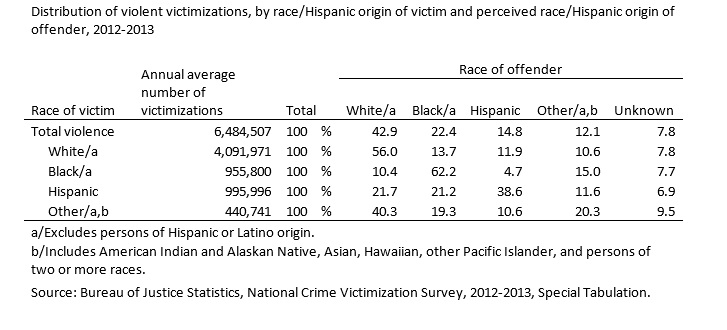The Justice Department's Hidden Race Data
Back in 2010, Ron Unz of The American Conservative set off a debate by arguing that Hispanics didn't have higher crime rates than non-Hispanic whites, and therefore crime shouldn't be a concern when it comes to immigration from Latin America. He had to argue this using a variety of roundabout calculations and obscure data sources, however, because good, national data weren't readily available.
For example, the federal government's National Crime Victimization Survey, which asks people about their experiences with crime, didn't allow interviewees to identify their attackers as "Hispanic." And the racial and ethnic offender breakdowns stopped being published in routine reports after 2008, though the raw numbers were still available in the full data sets.
It turns out the Justice Department has been holding out on us. It fixed the way it asked about offenders' races, but this went unnoticed because the data were no longer publicized. Heather Mac Donald got the numbers:

These data, in addition to being crucial for today's debates over criminal-justice disparities, allow us to do some quick math to check Unz's thesis. According to the Census, in 2012-13 there were 195 million non-Hispanic whites, 37 million non-Hispanic blacks, and 53 million Hispanics (of any race). And multiplying out the numbers in the top row above, we find that 2.8 million annual victimizations were perpetrated by whites, 1.5 million by blacks, and 960,000 by Hispanics.
Which allows us to (very roughly) estimate rates of committing violent crime, using victim surveys and thus avoiding some of the problems with arrest and conviction rates:
Whites 14 per 1,000
Blacks 40 per 1,000
Hispanics 18 per 1,000
So, Hispanics have a higher rate than whites — almost 30 percent higher. But Hispanics also tend to be younger. In the 2012-13 Census data, 41 percent of Hispanics are age 16-40, compared with 30 percent of whites and 36 percent of blacks. So, relative to whites, Hispanics are about 30 percent more likely to commit violent crimes, but also about 30 percent more likely to be in the age range where violent crimes are most common. If there's a gap, age might explain it, as Unz suggested.
There are caveats here. If Hispanic offenders are often perceived as white, black, or "other" by their victims, they won't be counted properly for comparison with the Census numbers. Hispanic is an ethnic rather than racial category, so it overlaps with racial groupings. (Five percent of Hispanics are black, for example.) Another thing to bear in mind is that immigrants tend not to commit crimes, while this is not true of their children; Hispanics are far more likely than whites to be foreign-born (35 percent vs. 4 percent). If it's fair to adjust for age, it might also be fair to adjust for nativity.
But on balance these numbers are somewhat favorable to Unz. Cutting the other way: Hispanics are about twice as likely as whites to be murdered, and several times as likely to show up at the ER with gunshot wounds.
Robert VerBruggen is editor of RealClearPolicy. Twitter: @RAVerBruggen




